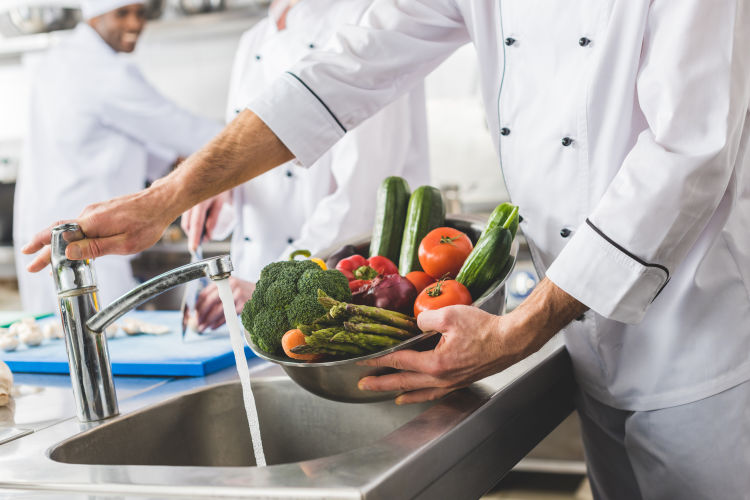You bit into the chicken, and some of its juices squirt out. The meat is silky and smooth, almost melting in your mouth. Half the chicken leg is gone, so in your mind, you decided you’ll eat a thigh next when suddenly, you see pink flesh on the leg you have just about demolished.
Can you feel your blood pressure rising? That’s nothing compared to the heights your blood pressure will scale if it happens to a customer in your restaurant. Raw chicken? That could close you down. Safeguard your interests and the welfare of your customers with measuring equipment and systems that will ensure every dish that leaves your kitchen is properly cooked.
In this writeup, food safety as it relates to cooking temperatures takes center stage, capped off by a description of a temperature measuring and monitoring setup that will work for professional kitchens.
Temperatures to Remember for Food Safety
The following are a few simple temperature rules one must remember in the interest of food safety.
The Danger Zone
At a temperature of 40°F up to 140°F, the number of bacteria in food can double every 20 minutes. Your goal, therefore, is to keep food out of this critical temperature range.
Therefore, you should not take raw meat out of the refrigerator unless you’re using it immediately. This is also why it’s safer to defrost frozen meat inside the fridge instead of on the kitchen counter.
Likewise, cooked food must also be stored properly to ensure it doesn’t remain in the dangerous temperature range. If food is not for immediate consumption, cool it down and store it in the refrigerator or freezer.
In sum, for food safety, food must be either very cold or very hot to prevent bacterial infestation.
Cooking Temperatures
When is meat adequately cooked? The following are the minimum temperatures food safety requires.
- 165°F
You must aim for this core temperature when cooking chicken and other poultry.
- 160°F
This is also the temperature you need to attain for ground pork, beef, lamb, and veal.
- 145°F
Pork, beef, lamb, and veal must reach an internal temperature of 145°F for safety. This applies to steaks, chops, and roasts.
Caveat: However, you should remember that the above minimum temperatures will make your food safe only if the raw ingredients have been appropriately handled. If raw meat has been left in the dangerous temperature range for too long, even cooking might not make it safe; bacteria may produce heat-resistant toxins.
Professional Temperature Measuring System for the Professional Kitchen
Professional food service operations need more than just instruments to take and measure cooking temperatures. They need a system to facilitate accurate, precise temperature monitoring and quality control.
A fully integrated temperature monitoring system typically has sensors and software.
- Sensors
The actual thermometers and food quality sensors make up this component. Restaurant personnel should have a selection of measuring probes for different applications. There are probes you insert into the food to measure core temperatures, but there are also probes for measuring surface temperature and ambient temperature. There are also general sensors – say, a sensor that monitors the refrigerator door to ensure it doesn’t remain open beyond the optimal time range.
The probes should have a digital readout. This will ensure that the person using the thermometer can have immediate feedback. In systems like Testo’s Saveris Restaurant, a multi-function handle provides the digital readout, and you can easily change the attached probe to whatever you require.
Finally, the measuring probes can report temperature measurements to a control unit via wireless transmission in advanced systems. The control unit is preloaded with the restaurant’s guided processes and checklists. It can sound an alarm when the oil in the fryer has reached the correct frying temperature or if the chicken in the oven has attained the ideal core temperature.
Therefore, advanced temperature sensor systems help not only with food safety. They also ensure food quality.
- Software
Advanced temperature measurement systems for the food service industry come with digital quality management software. In it, you can define and set your quality standards and digitize your restaurant’s quality handbook.
Next, you can roll out your quality guidelines to all your locations, no matter where they might be in the world. This makes convenient and quick updating of quality standards and policies in large, international restaurant chains a breeze.
Naturally, the software also allows for localization. Thus, individual locations can customize the quality handbook to suit on-site circumstances. Even so, the software ensures that thresholds and limits can remain inviolate by alerting concerned parties when these are breached.
Systematic Food Safety Monitoring
Temperature is critical to food safety and, of course, food quality. Therefore, restaurants, particularly large and busy ones — say, restaurants in a waterpark — require a system that will keep everyone aligned with defined quality guidelines and standard operating procedures. This forces compliance, ensuring the kitchen will always serve food that has been cooked safely and properly.
